Categoría "Ingeniería Quimica"
Se han encontrado 38 Coincidencias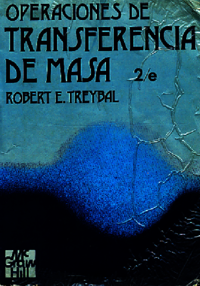
OPERACIONES DE TRANSFERENCIA DE MASA
103 Visitas | 366 Descargas | 2014-04-10 17:28:01 | raulito
Al presentar la tercera edición de este libro, mi propósito es el mismo que en la edición anterior: “proporcionar un instrumento para enseñar mediante un curso formal o autodidactico, las técticas y principios del diseño de equipo para las operaciones de transferencia de masa en Ingenieria química”. Al igual que ayer, estas operaciones son, en principio, responsabilidad del ingeniero químico pero en la actualidad resultan necesarias dentro de otras ramas de la Ingeniería. Por ejemplo, se necesitan, especialmente, en el control de la contaminación ambiental y en la protección del ambiente, donde predominan los procesos de eparación se requieren también en la metalurgia extractiva, que las utiliza con mayor frecuencia en métodos más complejos y precisos. Aproveché esta oportunidad para mejorar muchas explicaciones, actualizar los datos del diseño y para dar mayor fluidez a la reacción del texto. En esta edición se analizan temas como la teoría de la elongación de la interfase para la transferencia de masa, el enfriamiento por transpiración, nuevos tipos de torres de platos, adsorbedores sin generación de calor y otros temas similares. Se presentan métodos completos de diseño de mezcladores con sedimentadores y equipos de extracción de platos perforados; tanques de burbujeo y tanques con agitación mecánica para contacto gas-liquido, liquido-líquido y sólido-liquido; torres absorbedoras empacadas de tipo adiabático y enfriadores por evaporación. Se presentan nuevos ejemplos y problemas resueltos para que el estudiante adquiera práctica. Con objeto de mantener la extensión de este libro dentro de limites razonables, se omitió el estudio breve de las llamadas operaciones menos convencionales, que aparecía en el último capitúlo de la edición anterior.
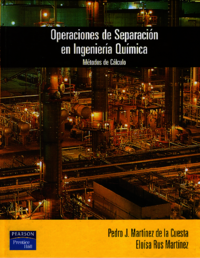
Operaciones de Separación en Ingeniería Química (Métodos de Cálculo)
104 Visitas | 354 Descargas | 2014-04-10 18:00:18 | raulito
El desarrollo de la profesión de Ingeniero Químico tiene, entre otras actividades, las de concebir, calcular, proyectar, hacer construir y hacer funcionar las instalaciones donde, de manera eficaz, se lleven a cabo reacciones químicas u operaciones de separación. La necesidad que el alumno de Operaciones de Separación tiene de disponer de libros en esta materia que le faciliten el conocimiento de la misma, nos llevó a la preparación de la obra Operaciones de Separación en Ingeniería Química. Métodos de Cálculo, que aborda de forma detallada y práctica las operaciones más importantes de la Ingeniería Química, tanto en contacto continuo propiamente dicho, como en cascada de etapas de equilibrio. La construcción de cada capítulo se encuentra fundamentada sobre bases físicas, químicas, matemáticas y económicas, bajo cuyos enfoques habrá que resolver los distintos problemas que se puedan presentar. En la redacción se utiliza un lenguaje conciso, de fácil comprensión, que permite una rápida transmisión de conocimientos y al mismo tiempo, puede conseguir la motivación del lector para formularse nuevas preguntas ante el reto que significa la mejor resolución del problema que se plantee.

Chemical Engineering Design and Analysis. An introduction.
57 Visitas | 76 Descargas | 2014-05-08 17:29:56 | raulito
Students taking their first chemical engineering course plunge into the "nuts and bolts" of mass and energy balances, often missing the broad view of what chemical engineers do. This innovative text offers a well-paced introduction to chemical engineering. The text helps students practice engineering. They are introduced to the fundamental steps in design and three methods of analysis: mathematical modeling, graphical methods, and dimensional analysis. In addition, students apply engineering skills, such as how to simplify calculations through assumptions and approximations; how to verify calculations, significant figures, spreadsheets, graphing (standard, semi-log and log-log); and how to use data maps. It also describes the chemical engineering profession. Students learn engineering skills by designing and analyzing chemical processes and process units in order to assess product quality, economics, safety, and environmental impact. This text will help students develop engineering skills early in their studies and encourage an informed decision of whether to study chemical engineering. Solutions manual available
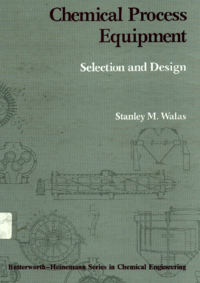
Chemical Process Equipment Selection and Design
64 Visitas | 58 Descargas | 2014-05-29 03:48:57 | raulito
This book is intended as a guide to the selection or design of the principal kinds of chemical process equipment by engineers in school and industry. The level of treatment assumes an elementary knowledge of unit operations and transport phenomena. Access to the many design and reference books listed in Chapter 1 is desirable. For coherence, brief reviews of pertinent theory are provided. Emphasis is placed on shortcuts, rules of thumb, and data for design by analogy, often as primary design processes but also for quick evaluations of detailed work.

Preliminary Chemical Engineering Plant Design
79 Visitas | 63 Descargas | 2014-05-29 03:58:38 | raulito
The idea for this book was conceived while I was on a Ford Foundation residency at the Dow Chemical Company in Midland, Michigan. I was assigned to the process engineering department, where I was exposed to all areas of process engineering, project engineering, and plant construction. My previous industrial experiences had been in pilot plants and research laboratories. Much to my surprise, I found that what was emphasized in the standard plant design texts was only a part of preliminary process design. Such areas as writing a scope, site selection, equipment lists, layout, instrumentation, and cost engineering were quickly glossed over. After I returned to Ohio University and began to teach plant design, I decided a book that emphasized preliminary process engineering was needed. This is the result. It takes the reader step by step through the process engineering of a chemical plant, from the choosing of a site through the preliminary economic evaluation.

Improving Plant Reliability through Data Collection and Analysis.
65 Visitas | 82 Descargas | 2014-05-29 04:00:36 | raulito
The unique value of this book is that it is the defining document for an industry-wide Plant and Equipment Reliability Database. The intent, structure, and implementation of the database are described fully within the book and its appendices. This Guideline book, developed for the Center for Chemical Process Safety (CCPS), is designed as a text to be used by operating and maintenance staff, reliability engineers, design engineers, and risk analysts. it treats the broad topic of equipment reliability, but also provides details about the design and operation of a process-plant/equipment reliability database. The major objective of this book is to lay the foundation for an industry-wide reliability database. In fulfilling this objective, the book satisfies three auxiliary objectives. The first is to document and explain the theory of reliability data, including failure rates and the data structure employed by CCPS to accomplish its goals. The second is to demonstrate the usefulness of quality data by presenting worked examples. The text emphasizes that data needs are driven by analyses that provide added value. The book will help to illustrate this point. It will also help the reader understand how to actually carry out the analyses. The third objective is to provide an overview for the necessary quality assurance that must be implemented by both the plants maintaining a local database and a centralized database administrator to whom data is submitted for aggregation and distribution.
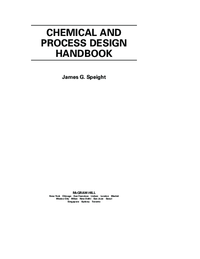
CHEMICAL AND PROCESS DESIGN HANDBOOK
90 Visitas | 68 Descargas | 2014-05-29 04:02:37 | raulito
This book emphasizes chemical conversions, which may be defined as chemical reactions applied to industrial processing. The basic chemistry will be set forth along with easy-to-understand descriptions, since the nature of the chemical reaction will be emphasized in order to assist in the understanding of reactor type and design. An outline is presented of the production of a range of chemicals from starting materials into useful products. These chemical products are used both as consumer goods and as intermediates for further chemical and physical modification to yield consumer products.

CHEMICAL ENGINEERING DESIGN PROJECT A Case Study Approach
53 Visitas | 69 Descargas | 2014-05-29 04:05:11 | raulito
This book provides a case study approach for the teaching and appreciation of the work involved in a chemical engineering design project. Ail undergraduate chemical engineering students are required to perform a design project, usually in the final year of the course. It may be the last piece of work that a student completes (after all other subjects have been examined) prior to graduation, carried out over a period of between 6 to 10 weeks (depending upon departmental policy). Alternatively, the design project may be performed during the entire final year of study. No doubt, variations on these alternatives occur in certain faculties.
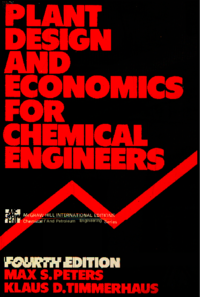
PLANT DESIGN AND ECONOMICS FOR CHEMICAL ENGINEERS Fourth Edition
60 Visitas | 82 Descargas | 2014-05-29 04:12:35 | raulito
Advances in the level of understanding of chemical engineering principles, combined with the availability of new tools and new techniques, have led to an increased degree of sophistication which can now be applied to the design of industrial chemical operations. This fourth edition takes advantage of the widened spectrum of chemical engineering knowledge by the inclusion of considerable material on profitabilty evaluation, optimum design methods, continuous interest compounding, statistical analyses, cost estimation, and methods, for problem solution including use of computers. Special emphasis is placed on the economic and engineering principles involved in the design of chemical plants and equipment. An understanding of these principles is a prerequisite for any successful chemical engineer, no matter whether the final position is in direct design work or in production, administration, sales, research, development, or any other related field. The expression plant design immediately connotes industrial applications; consequently, the dollar sign must always be kept in mind when carrying out the design of a plant. The theoretical and practical aspects are important, of course; but, in the final analysis, the answer to the question “Will we realize a profit from this venture?” almost always determines the true value of-the design. The chemical engineer, therefore, should consider plant design and applied economics as one combined subject. The purpose of this book is to present economic and design principles as applied in chemical engineering processes and operations. No attempt is made to train the reader as a skilled economist, and, obviously, it would be impossible to present all the possible ramifications involved in the multitude of different plant designs. Instead, the goal has been to give a clear concept of the important principles and general methods. The subject matter and manner of presentation are such that the book should be of value to advanced chemical engineering undergraduates, graduate students, and practicing engineers. The information should also be of interest to administrators, operation supervisors, and research or development workers in the process industries.

FENÓMENOS DE TRANSPORTE
65 Visitas | 79 Descargas | 2014-05-29 04:22:50 | raulito
En este libro se intenta presentar una introducción al tema de los fenómenos de transporte para estudiantes de ingeniería y ciencia aplicada, mediante el estudio del transporte de cantidad de movimiento (flujo viscoso), transporte de energía (conducción del calor, convección y radiación), y transporte de materia (difusión). Se considera siempre que los medios en los que tienen lugar los fenómenos de transporte son continuos, y apenas si se hace referencia a la explicación molecular de los procesos. Tal tratamiento a base de un medio continuo presenta un interés más inmediato para los estudiantes de ingeniería, pero es preciso tener en cuenta, sin embargo, que ambos puntos de vista (continuo y molecular) son necesarios para adquirir un completo dominio del tema.

TRANSPORT PHENOMENA A Unified. Approach
63 Visitas | 92 Descargas | 2014-05-29 04:25:13 | raulito
This book was designed to provide an integrated treatment of the three areas of transport: momentum, heat, and mass. The similarities and the differences of the three transports are clearly stated at a level suitable for second-semester sophomores and first-semester juniors in engineering or the other sciences where the mathematics requirement is similar. Many of the basic equations are mathematically identical, when expressed in terms of the generalized flux and property variables. This identity helps the student understand transport phenomena and forms the basis for the organization of the material here. A typical curriculum teaches momentum transfer before heat and mass because a complete treatment of these latter two is not possible without a prior discussion of fluid dynamics. This text allows heat transfer, which is encountered daily by everyone and easily visualized, to explain by analogy momentum transfer, which is not easily visualized or understood by neophytes. Transport is rapidly becoming more widely used in most branches of engineering, and this text provides all engineering disciplines with a readable and otherwise useful treatment of this difficult subject. In most of the other books on this subject, these topics are covered separately.
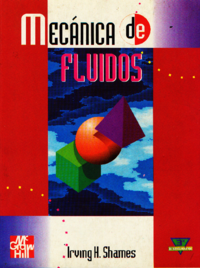
*MECÁNICA DE FLUIDOS
110 Visitas | 136 Descargas | 2014-05-29 04:27:25 | raulito
Con la publicación de la tercera edición, este texto empieza la cuarta década de su existencia. En retrospectiva, ha tenido tres etapas de desarrollo. La primera edición representó un despegue radical de los textos sobre fluidos en su tiempo. Por ejemplo, fue el primer texto que utilizó la ecuación de transporte de Reynolds para establecer las formas integrales de las leyes básicas mediante volúmenes de control. Asimismo, fue el primer texto que introdujo y utilizó el volumen de control no inercia]. Además, presentó la deducción de la ley de viscosidad de Stokes y la formulación y el uso de las ecuaciones de Navier-Stokes. Estas innovaciones demostraron ser acertadas, ya que la primera edición se utilizó ampliamente; llegó a 22 impresiones durante 20 años antes de dar paso a la segunda edición. La segunda edición se centró en el nrbrimipjztu de los temas. Se agregaron capítulos sobre turbomaquinaria, mecánica computacional de fluidos y un apéndice sustancial sobre instrumentación. También se completaron otros capitulos, particularmente el capítulo sobre capa límite. El desarrollo de la tercera edición se facilitó debido a una gran oportunidad. Corno profesor de facultad mi enseñanza no está restringida a un solo departamento. Por consiguiente, a pesar de que pertenezco al departamento de ingeniería civil, en 1979 fui invitado por nuestro departamento de ingeniería mecánica y aeroespacial para dirigir el curso de segundo año en mecánica de fluidos a los estudiantes y tuve completa libertad en la forma de presentación y contenido del curso. Ha habido entre 160 y 180 estudiantes cada año en esta clase. Particularmente valioso para mí fue el hecho de que la mitad de la clase estaba compuesta por estudiantes de transferencia de una amplia gama de programas, que variaban desde programas de ingeniería de universidades grandes hasta programas de preingeniería de universidades pequeñas. Mi experiencia de enseñar a una clase grande de estudiantes con diferentes tipos de preparación ha sido la mejor forma para desarrollar un libro. Por consiguiente, se me presentó una oportunidad única para trabajar en la tercera edición. Asimismo, para compensar la extraordinaria confianza dada por mis colegas en el departamento de ingeniería mecanica y aeroespacia), hubo una gran motivación para mejorar el libro, en particular desde el punto de vista pedagógico. La tercera edición es el resultado de un esfuerzo continuo, primordialmente en esta dirección, durante toda una década. Ahora presento algunos de los cambios hechos durante este periodo.

Wastewater Microbiology
69 Visitas | 70 Descargas | 2014-12-06 17:11:12 | raulito
The second edition of Wastewater Microbiology incorporates the latest findings in a field covering a wide range of topics. During the past few years, we have witnessed significant advances in molecular biology, leading to the development of genetic probes, particularly the ribosomal RNA (rRNA) oligonucleotide probes, for the identification of wastewater microorganisms. The road is now open for a better identification of the microbial assemblages in domestic wastewater and their role in wastewater treatment.

INGENIERÍA DE LAS REACCIONES QUíMICAS
70 Visitas | 131 Descargas | 2014-12-06 17:15:22 | raulito
La Ingeniería de las reacciones químicas es la rama de la Ingeniería que estudia las reacciones químicas a escala industrial. Su objetivo es el diseño y funcionamiento adecuado de los reactores químicos, y probablemente la Ingeniería de las reacciones químicas es la actividad que, por sí sola, hace que la Ingeniería química constituya una rama de la Ingeniería. En una determinada situacidn, el técnico se enfrenta con una serie de cuestiones: la información necesaria para abordar un problema,‘cómo obtener la información más adecuada y cómo seleccionar el diseño más favorable entre las distintas alternativas posible. El objeto de este libro es enseñar a responder a estas preguntas adecuadamente. Para esto se le da gran importancia a los argumentos cualitativos, a métodos de diseño sencillo, a los procedimientos gráficos y a la comparación entre los distintos tipos de los reactores más importantes; con ello se pretende desarrollar un fuerte sentido intuitivo orientado hacia el diseño más acertado, que puede después guiar y reforzar los métodos formales de diseño. Este es un libro de rexto y, por lo tanto, se estudian en primer lugar una serie de conceptos sencillos que después se extienden a fenómenos más complejos. Por otra parte, se insiste más en el desarrollo de una técnica de diseño aplicable a todos los sistemas, tanto homogéneos como heterogéneos.

Hitos de la Química
79 Visitas | 97 Descargas | 2014-12-06 17:18:53 | raulito
La química siempre ha estado tan estrechamente ligada a nuestro planeta que no andaríamos muy desencaminados si afirmásemos que la Tierra y los millones de seres vivos que la habitan, son en sí mismos un prodigioso conjunto de reacciones químicas complejas y extraordinarias. La química no sólo dio vida a nuestro planeta, sino que desde su origen se ha convertido en el motor que ha permitido avanzar a la Humanidad. Sin el desarrollo de esta ciencia, nuestra vida sería muy diferente. Realmente, sería extremadamente corta. Sin medicamentos, vacunas o antibióticos, sin sustancias para potabilizar el agua, sin productos que garantizan nuestra higiene o que protegen y mejoran el rendimiento de los cultivos, pocas aspiraciones podríamos tener más allá de la mera subsistencia. Pero estas son sólo algunas de las aportaciones esenciales. Sin la química, no podríamos circular en automóviles, navegar por internet, hablar con nuestros móviles o simplemente leer un libro, escuchar un disco o ir al cine. En definitiva. todo el conjunto de aportaciones de esta maravillosa ciencia nos han facilitado la existencia y el bienestar.

The Requirements Engineering Handbook
Team DDU
102 Visitas | 161 Descargas | 2014-12-06 17:22:03 | raulito
This book is intended as a concise but thorough ready reference for requirements analysts (RAs)—those who are assigned to determine the requirements for planned systems and software, both in computing and engineering. It is a desk guide/handbook that focuses on how RAs can best perform their work. The requirements are key to the success or failure of technical projects. They are the basis of all of the follow-on work. It’s been my experience that most projects and organizations fail to use effective requirements practices and a documented requirements process, and also that those assigned as RAs are cast into the needed work without proper preparation, experience and training, and without a good handbook that advises them on how to perform their roles and what to do.

CHEMICAL ENGINEERING A NEW PERSPECTIVE
94 Visitas | 78 Descargas | 2014-12-06 17:50:13 | raulito
Chemical engineering has often been referred to as a study in methodology. The author, however, doubts the veracity of such a statement. Approaches in chemical engineering, as observed by the author, are determined by individual phenomena/processes, and each of these phenomena/processes is studied individually. Moreover, associated or related phenomena/processes are not considered, despite them being a part of the same chemical engineering field. In fact, the author was unable to perceive an obvious connection between such methods, and therefore, believes that chemical engineering is clearly not a study in methodology that is based on a consistent viewpoint.

BIOFUEL
80 Visitas | 112 Descargas | 2014-12-06 18:02:01 | raulito
Cellulose — in particular, cellulose in “lignocellulosic biomass” — embodies a great dream of the bioorganic chemist, that of harnessing the enormous power of nature as the renewable source for all the chemicals needed in a modern, biosciencebased economy.1 From that perspective, the future is not one of petroleum crackers and industrial landscapes fi lled with the hardware of synthetic organic chemistry, but a more ecofriendly one of microbes and plant and animal cells purpose-dedicated to the large-scale production of antibiotics and blockbuster drugs, of monomers for new biodegradable plastics, for aromas, fragrances, and taste stimulators, and of some (if not all) of the novel compounds required for the arrival of nanotechnologies based on biological systems. Glucose is the key starting point that, once liberated from cellulosic and related plant polymers, can — with the multiplicity of known and hypothesized biochemical pathways in easily cultivatable organisms — yield a far greater multiplicity of both simple and complex chiral and macromolecular chemical entities than can feasibly be manufactured in the traditional test tube or reactor vessel.

Ionic transport Processes
84 Visitas | 65 Descargas | 2014-12-06 18:05:04 | raulito
Transport phenomena constitute an integral part of electrode and membrane processes. Electrode reactions are heterogeneous and take place on the electrode surface, thus creating concentration differences in the electrode vicinity, and these differences cause mass transport. In membrane processes, analogous surface phenomena occur in many cases, but in addition, transport processes inside the membrane phase can also be decisive. The characteristic feature of the information obtained from a transport phenomenon is that measurable quantities represent integral values over the entire surface under study. This means that in, e.g., electrode processes, only the response function of the chosen perturbation function that has been fed into the system can be measured. In some cases, however, it is possible to get complementary spectroscopic information of the surface. When modelling a heterogeneous process, transport phenomena are of great importance but they alone do not describe the entire process sufficiently.Various surface phenomena and reactions must be included in the model. And it has to be realized that the study of these surface phenomena, e.g. adsorption, is possible only after the solution of the inherent transport problem and after the subtraction of its effect on the entire process. Thus, a comprehensive model of a heterogeneous process is mathematically rather demanding.

CONTROL AUTOMÁTlCO DE PROCESOS TEORíA Y PRÁCTICA
103 Visitas | 118 Descargas | 2014-12-16 13:40:40 | raulito
El propósito principal de este libro es mostrar la práctica del control automático de proceso, junto con los principios fundamentales de la teoría del control. Con este fin se incluye en la exposición una buena cantidad de análisis de casos, problemas y ejemplos tomados directamente de la experiencia de los autores como practicantes y como consultores en el área. En opinión de los autores, a pesar de que existen muchos libros buenos en los que se tratan los principios y la teoría del control automático de proceso, en la mayoría de ellos no se proporciona al lector la práctica de dichos principios. Los apuntes a partir de los cuales se elaboró este libro se han utilizado durante varios años en los cursos finales de ingeniería química y mecánica en la University of South Florida y en la Louisiana State University. Asimismo los autores han utilizado muchas partes del libro para impartir cursos cortos a ingenieros en ejercicio activo en los Estados Unidos y en otros países. El interés se centra en el proceso industrial y lo pueden utilizar los estudiantes del nivel superior de ingeniería, principalmente en las ramas de química, mecánica, metalurgia, petróleo e ingeniería ambiental; asimismo, lo puede utilizar el personal técnico de procesos industriales. Los autores están convencidos de que, para controlar un proceso, el ingeniero debe entenderlo primero; a ello se debe que todo el libro se apoye en los principios del balance de materia y energía, el flujo de líquidos, la transferencia de calor, los procesos de separación y la cinética de la reacción para explicar la respuesta dinámica del proceso. La mayoría de los estudiantes de los grados superiores de ingeniería tienen las bases necesarias para entender los conceptos al nivel que se presentan. El nivel de las matemáticas que se requieren se cubre en los primeros semestres de ingeniería, principalmente el calculo operacional y las ecuaciones diferenciales.
Contribuir
Usted puede contribuir con Libros UCLV, es importante para nosotros su aporte..
Contribuir